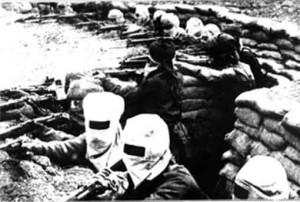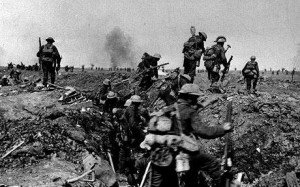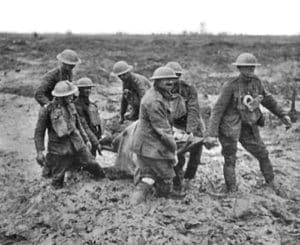The Second Battle of Ypres
- Fought outside of Ypres, Belgium in 1915
- Germans trying to break west and south through the “Ypres salient”. A bulge jutting into German lines
- Germans used Chlorine Gas, first use of Poison Gas in war
 The yellow-green gas killed almost everything in its path, men, horses and birds
The yellow-green gas killed almost everything in its path, men, horses and birds
- The chlorine burned the eyes, nose and throat and destroyed the lungs. Men drowned in their own bodies as their lungs filled with fluid
- French troops, in the trenches beside CDNs were gassed first…they either died or ran – leaving a huge gap in the line
- CDN troops, never in battle before and massively outnumbered, held their trenches
- The CDN troops were also gassed but held on
- As the story goes…a well educated CDN soldier recognized the smell of chlorine gas and realized that by urinating on a piece of cloth and wearing it over the mouth and nose, the chlorine would be neutralized by the ammonia in the urine
- The CDN slowed the German attack which allowed British soldiers to arrive and completely stop the attack, (after furious fighting for a number of days)
- In the end, over 6000 CDNs were killed in the 2nd Battle of Ypres
- 1 in 5 men were either killed, gassed, wounded or missing
- The Canadians began to earn a reputation as being brave troops, who would fight hard under and conditions. (This would grow quickly as the war progressed)
The Battle of the Somme
Summer 1916
- British forces had to do something to relieve the pressure on the French
- make a large scale attack somewhere
- Commander of all British forces, Sir Douglas Haig decided to attack along the Somme River
- Plan was 5 day artillery Barrage (firing 1.5 Million shells), destroy the German defenses and kill the soldiers, then advance
- also to use Tanks for the first time in warfare
Problems from the Start
- things were rushed to help the French
- most of the shells fired were Shrapnel Shells and did little damage to the defenses
- German Soldiers were safe underground in bunkers
- The shrapnel shells supposed to be used to destroy barbed wire defenses
The Battle Begins
 British Barrage can be heard across the English Channel in England (that’s very very loud by the way)
British Barrage can be heard across the English Channel in England (that’s very very loud by the way)
-
- British engineers explode large Mines dug under German positions
- British soldiers “Go Over the Top” and form into lines to walk across No Man’s Land – expecting Germans to be dead or gone (can you see a problem here???)
- Lines of men made easy targets for German machine gunners, who had been safe inside their dugouts during the Barrage
- Some British units managed to take their objectives, others were shot to pieces
- On July 1, 1916, the British Army suffered 57,000 casualties
- (the worst single loss EVER in British history)
- By November, the Battle ground to a halt
| Gains | Losses
|
|
|
- Canadian Commanders were shocked at the careless and needless loss of their men (25,000)
- Vowed that never again would Canada simply follow the British into battle
Battle of Vimy Ridge
|
– First time all 4 CDN Divisions fought together
– used to spearhead nearly every major British offensive for the rest of the war – commanded for the rest of the war by General Currie |
|
– miles of railway laid quickly transport men & equipments in preparation for battle
– “Subways” dug to hide the preparations & men in the hours before the attack (the Germans have the high ground and could see for miles) |
|
– EACH platoon would include riflemen, machine gunners and bombers (with grenades)
– the platoons have all the tools they need and can advance quickly (don’t have to wait for specialist troops to come up & help) |
|
– troops practice on full scale models of the battlefield laid out with coloured tape * signs like a giant map (they know where they are to go and what defenses are in their area)
– troops could examine a detailed scale model of the battlefield to have a better sense of their jobs |
|
– for one of the first times in war nearly all soldiers were issued a map of the battlefield, not just the officers |
|
– location of nearly all German artillery is known BEFORE the battle and is destroyed in the opening Canadian barrage |
|
– version of the Creeping Barrage
– soldiers will advance 100 yards every 3 minutes while the artillery barrage advances to keep the Germans pinned down until the troops are on the German trenches |
|
– all of Canada shares in the victory of Vimy Ridge
– for the first time CDNs now have a common event in their history – men from all the provinces and territories fought at Vimy Ridge together – after the war, they all have the same unifying point in their lives – soldiers and civilians – a CANADIAN experience |
Battle of Passchendaele
- November, 1917
- For months British General Haig had tried unsuccessfully to take Passchendaele Ridge in Belgium. He then passed the job along to Canadian General Arthur Currie
- Heavy bombardments and rain had turned the landscape to mush. Currie warned Haig that these conditions would result in many casualties, but Haig was insistent
- Many horses and soldiers actually drowned in flooded trenches and shell craters
- Canadians took the low ridge and the nearby village in two weeks of hard fighting
- Almost 16 000 CDN dead or wounded
Importance:
- Passchendaele marked the first battle in which CDN troops were led by their own General instead of a British one
- Afterwards, Gen. Currie reported to Canadian Prime Minister Borden his disgust for the battle conditions
- Both Currie and Borden felt that the victory was not worth the human cost
- The next time PM Borden met with the British PM he threatened that any repeat of Passchendaele would mean no more CDN troops would be sent to Europe


“The yellow-green gas killed almost everything in its path, men, horses and birds”
No it didn’t. No Great War gas was so efficient and deadly. Survival rates for Chlorine gas were about 60%, though a huge number of men were left with debilitating lung disease.